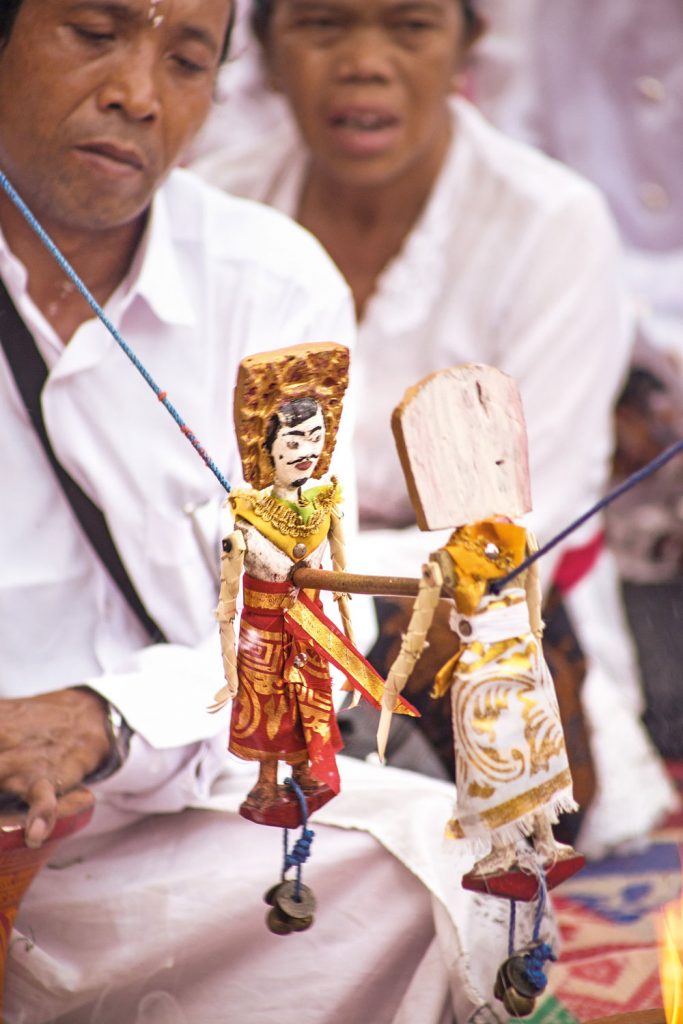The audience were sitting silently when the congregation, who sat on the stage of Kalangan Angsoka amphitheatre started singing a hymn, verses of a sacred song known as Gending Sanghyang. Gending Pangembak filled the atmosphere as the ritual began. The song is believed to have the power to summons deities and noble spirits, key to this eye-opening Balinese dance or performance. There, on the stage, two gentlemen sat on the floor; each of them holding a pole connected by string where two figurines, a female and a male character made of sandalwood and palm leaf, hung on the string.

As an annual event, Bali Art Festival not only acts as a great vehicle to promote the regeneration of Balinese art and culture, but also serves as an opportunity to introduce sacred performances to both Balinese locals and visitors to the island. The intention is, of course, not to turn the sacred ritual or performance into a commercial one, but to build awareness that there are dozens of various ancient and sacred rituals that are still enlivened and performed as part of religious ceremonies by the people of the island.
Jero Wacik Ketut Sedana and Jero Dasaran Ketut Sejaya along with a group from Banjar Belonging to the Kangin, Abangsongan Village of Bangli Regency, were performing an ancient ritual of their village in the event of Bali Art Festival 2016. Sedana and Sejaya acted as Tetunggu, people who are gifted and able to hold the poles for the ritual. Presently, there are only 3 pairs of Tetunggu because to become a Tetunggu a person needs to have patience and willingness to worship God with a pure heart. As the hymn continued and the fume of the incense rises into the sky, Mr. Sedana’s and Mr. Sejaya’s hands started trembling and the vibrations began to get stronger and stronger. The noble spirits had arrived and entered the bodies of the two figurines.

Several rituals were done in order to successfully bring this sacred performance on the stage of Bali Art Festival. The ceremonies were conducted at the village and on a stage. Sanghyang Deling must be performed while facing to the mountain or the north, which was the reason why for the Bali Art Festival the performance was orientated to the wall instead of to the audience. However, some other sacred and magical entities and acts were not performed on the stage.
In Abangsongan Village at Dadia Pande Sesana Temple, Sanghyang Deling is performed every 15 days on a holy day known as Kajeng Kliwon. This sacred performance has been part of the village ritual for health and prosperity since 1958. Their ancestors actually had performed Sanghyang Deling for decades, but then there was a generation gap where the ritual was forgotten and not performed. In 1958, a plague stuck the village, causing not only the people to get sick, but also causing their crops to wilt and die. Lengthy meditations were carried out by the village’s priest and he received a vision that the village should perform a ritual that involved Sanghyang Deling. After the ritual was done the plague slowly diminished and the village became prosperous once again.
As the hymn continued to the next verse called Gending Pareremanl, the hands of the Tetunggu begun to shake more and the figurines swung wildly. However, it was not the hands of the Tetunggu that caused the swinging of the figurines. When the song stopped the figurines also stopped swinging, even though the hands of Tetunggu were still shaking. When the tempo increased, the figurines swung even wilder. Eventually, the hymn slowed down as they continued singing the last verse called Gending Penyineb. The performance finally ended with a prayer and the congregation receiving holy water from the priest.









